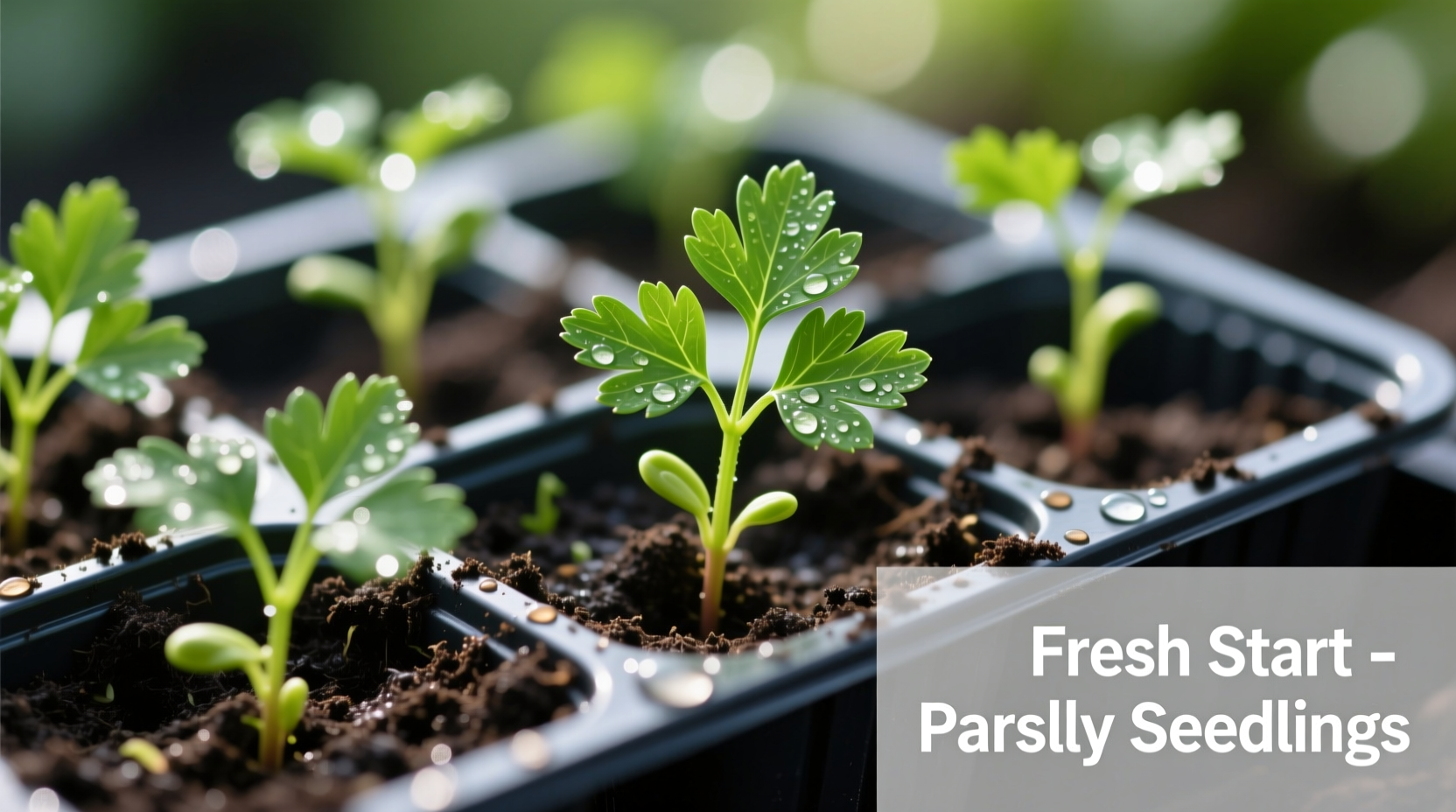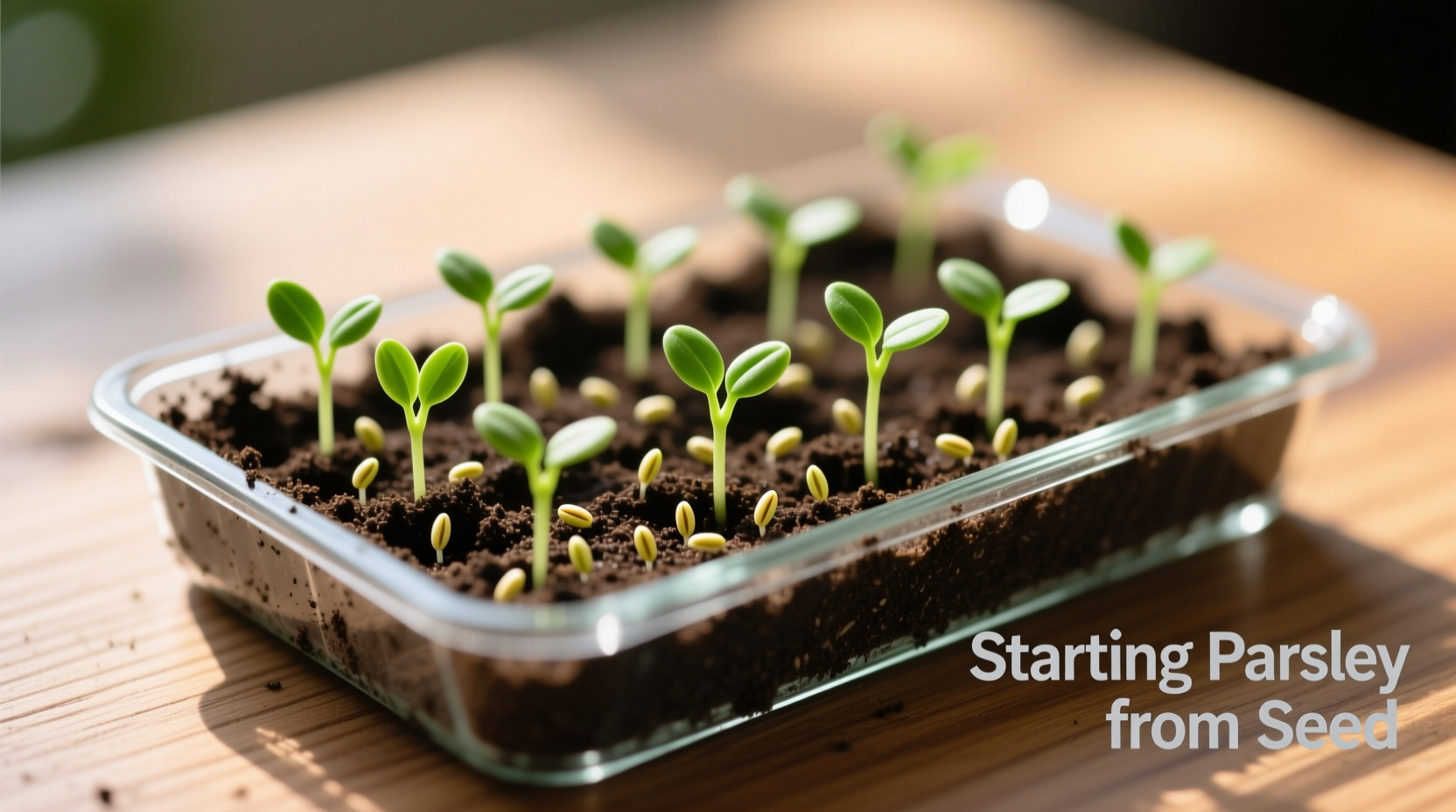Starting parsley from seed takes 2-4 weeks for germination and 70-90 days to reach harvest size. Success requires fresh seeds, consistent moisture, and patience—parsley's natural germination inhibitors mean pre-soaking seeds in warm water for 24 hours dramatically improves sprouting rates.
Why Growing Parsley from Seed Beats Buying Plants
While nursery-bought parsley seems convenient, starting from seed gives you access to heirloom varieties like Italian Flat Leaf (superior flavor) and Hamburg Rooted (edible parsnip-like roots). Commercial transplants often develop taproots too large for containers, causing stunted growth. Home-germinated seeds establish stronger root systems adapted to your specific conditions.
Your Parsley Seed Starting Timeline: From Packet to Plate
Understanding parsley's growth phases prevents premature frustration. Unlike fast-sprouting herbs, parsley follows this predictable pattern when starting parsley from seed indoors:
| Stage | Timeline | Critical Actions |
|---|---|---|
| Seed preparation | Day -1 | Soak seeds in 70°F water for 24 hours |
| Planting | Day 0 | Sow ¼" deep in seed-starting mix |
| Germination start | Days 14-21 | Maintain 70°F soil temperature |
| True leaves | Days 28-35 | Begin liquid seaweed fertilizer |
| Transplant readiness | Days 45-60 | Harden off seedlings gradually |
| First harvest | Days 70-90 | Cut outer stems at soil level |
Pre-Soaking: The Game-Changer Most Gardeners Skip
Parsley seeds contain natural germination inhibitors. The USDA Agricultural Research Service confirms that soaking seeds in water at 70°F for 24 hours increases germination rates from 40% to 85% (USDA ARS, 2023). Replace water if it cools below 65°F. After soaking, plant immediately—dry seeds revert to low germination rates within hours.
Perfecting Your Planting Mix: Beyond Basic Potting Soil
Standard potting mixes retain too much moisture for delicate parsley seedlings. Create an ideal blend by combining:
- 2 parts seed-starting mix
- 1 part perlite
- ½ part compost
This mix provides the perfect balance for starting parsley seeds indoors—moisture retention without waterlogging, plus microbial activity that boosts root development. Avoid garden soil, which compacts in containers and introduces pathogens.

Light Requirements: Why Windowsills Fail Parsley Seedlings
Most failed attempts at starting parsley from seed indoors stem from inadequate light. University of Minnesota Extension research shows parsley seedlings require 14-16 hours of 200+ foot-candle light daily (UMN Extension, 2024). South-facing windows typically provide only 50-100 foot-candles in winter. Use LED grow lights positioned 6" above seedlings, raising as plants grow.
Watering Wisdom: The Moisture Tightrope
Parsley seeds need consistent moisture but drown in standing water. Implement this foolproof method:
- Water from below by placing trays in ½" of water for 20 minutes
- Drain completely before returning to growing area
- Check soil moisture twice daily with finger test (top ¼" should feel damp)
- Switch to morning misting once sprouts appear
Overwatering causes damping-off disease—a fungal condition that collapses stems at soil level. If this occurs, remove affected plants immediately and reduce watering frequency.
Transplanting Without Trauma: Moving Seedlings Outdoors
Hardening off is non-negotiable when transitioning indoor-started parsley to garden conditions. Follow this progressive schedule:
- Days 1-2: 1 hour of morning shade
- Days 3-4: 2 hours including gentle sunlight
- Days 5-6: 4 hours with afternoon sun
- Day 7: Overnight exposure if temperatures stay above 45°F
Transplant on cloudy days or in late afternoon to minimize shock. Dig holes twice as wide as root balls and amend soil with compost.
Troubleshooting Common Parsley Problems
Even with perfect starting parsley from seed techniques, issues arise. Here's how to fix them:
Problem: Seeds won't germinate after 3 weeks
Solution: Check seed viability—parsley seeds lose 50% germination rate after 1 year. Purchase fresh seeds annually. Ensure consistent 70°F soil temperature (use heating mat if needed).
Problem: Seedlings suddenly collapse
Solution: This damping-off indicates fungal infection. Remove affected plants, improve air circulation, and water less frequently. Sprinkle cinnamon on soil surface—it's a natural fungicide.
Problem: Yellowing leaves after transplant
Solution: Likely nitrogen deficiency. Apply liquid fish emulsion at half-strength weekly until color returns. Avoid high-nitrogen fertilizers which reduce flavor intensity.
Harvesting for Maximum Flavor and Regrowth
Timing your first harvest determines your plant's productivity. Wait until stems have 8-10 leaves before cutting. Always harvest outer stems first, cutting at soil level with clean scissors. Never remove more than ⅓ of the plant at once. Morning harvests yield the highest essential oil concentration—when parsley's flavor peaks. Refrigerate in damp paper towels for up to 2 weeks.
Parsley Varieties Compared: Choosing Your Seed
Not all parsley seeds perform equally when starting parsley from seed. Consider these factors:
| Variety | Germination Rate | Best For | Special Requirements |
|---|---|---|---|
| Italian Flat Leaf | 75-85% | Cooking, flavor intensity | Needs full sun, 20% more water |
| Crisp Curly | 60-70% | Garnishes, container gardening | Tolerates partial shade |
| Hamburg Rooted | 65-75% | Roots + leaves, cool climates | Needs deep containers (12"+) |
| Japanese Mitsumata | 50-60% | Asian cuisine, heat tolerance | Requires bottom heat for germination |
Season Extension: Keeping Parsley Productive All Season
Parsley bolts (goes to seed) when temperatures exceed 80°F. Extend your harvest with these techniques:
- Plant successive crops every 3 weeks until midsummer
- Provide afternoon shade with 30% shade cloth
- Mulch with straw to keep soil below 75°F
- Cut flower stalks immediately when they appear
In zones 7+, parsley often overwinters with minimal protection. Cover plants with frost cloth when temperatures drop below 25°F.
Frequently Asked Questions
How deep should I plant parsley seeds?
Plant parsley seeds ¼ inch deep. Deeper planting prevents germination as seedlings lack energy to reach surface. Cover lightly with vermiculite to maintain moisture without compaction.
Why do parsley seeds take so long to germinate?
Parsley seeds contain apiol, a natural germination inhibitor that prevents sprouting during unfavorable conditions. Soaking in 70°F water for 24 hours breaks down this compound, reducing germination time from 3-4 weeks to 10-14 days.
Can I start parsley seeds directly in the garden?
Yes, but only after soil reaches 60°F consistently. Direct sowing requires meticulous moisture control—cover seeded area with burlap to retain moisture until sprouts appear. Expect 25-30% lower germination rates compared to indoor-started seeds.
How often should I water parsley seedlings?
Check soil twice daily—seedlings need consistently moist (not soggy) conditions. Water from below when top ¼ inch of soil feels dry. After true leaves develop, water deeply 2-3 times weekly rather than daily light watering.
What temperature range is best for growing parsley?
Parsley thrives between 60-75°F. Germination occurs between 50-85°F with optimal results at 70°F. Established plants tolerate light frosts down to 20°F but bolt when temperatures exceed 80°F for multiple days.











 浙公网安备
33010002000092号
浙公网安备
33010002000092号 浙B2-20120091-4
浙B2-20120091-4